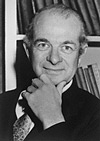Rotation about N-Ca angle is F Rotation about Ca-C angle is called Y These are called the torsion angles, or FY angles A plot of such angles is called a Ramachandran diagram. G.N Ramachandran died in April 2001 (story)
Gly has the most permitted angles, because of its small size. Pro has a fixed F angle because of its ring

In the early 1950's Linus Pauling (see also) predicted the alpha-helix based on the following assumptions and principles.
- Bond lengths and bond angles in proteins should be the same as in small molecules, such as free amino acids.
- Peptide bonds should be planar and trans.
- Van der waals contacts should be maximized (no cavities too small for water).
- H-bonding of backbone groups should be maximized.
Since each residue has one CO and one NH, the simplest way to H-bond all of these is in a repetitive pattern. Notice that they can H-bond to each other.
This led to the structure of the Alpha-helix (Chime link)
- 3.6 residues per turn, 1.5 Angstrom rise per residue, 5.4 Angstrom rise per turn (pitch). 5 turns have exactly 18 residues (27 Angstrom)
- F = -57° , Y = - 47°
- H-bonds are nearly parallel to helix axis, from CO of ith residue to NH of i+4th residue
- Helix is right handed
- Side chains point out
- Close packing inside, no hole down the helix.
- Guided Exploration #6 (Compare the helices)
- See the Animation
Other helices are possible
| alpha | (C=O)n ----> (N-H)n+4 | very common, ave. length 12 aa |
| 3-10 | (C=O)n ----> (N-H)n+3 | rare, ave. length 3-4 |
| 2.2-7 | (C=O)n ----> (N-H)n+2 | does not exist ? |
| p | (C=O)n ----> (N-H)n+5 | very rare, 5 residues |
Beta-sheets
- Also predicted by Pauling
- 2 Varieties, parallel or anti-parallel
- Backbones are nearly fully extended
- Sheets are formed by 2 or more strands
- Strands are H-bonded to neighboring strands via backbone CO and NH groups.
- Parallel sheets are formed from strands that run in the same direction
- Anti-parallel sheets are formed from strands that run in opposite directions
- Mixed sheets are possible.
- FY angles are about -120-140° each
- anti-parallel: 3.4 Angstrom rise per residue
- H-bonds between strands are perpendicular to strands
- parallel: 3.2 Angstrom rise/residue
- H-bonds between strands are angled
- In a b-sheet, the side chains of residues 1, 3, 5, ... of a strand are on the same side of the sheet. Residues 2, 4, 6, ... are on the other face.
- See the Chime exercise about b-sheet
- Mouse Control
- Guided Exploration #7
- See the Animation
Turns
Proteins can be seen as composed of elements of secondary structure-predominantly a-helices and b-sheets-and the segments of polypeptide chains that connect those elements. Short connections are termed turns. Some short turns, called b-turns have 3-5 residues and well-defined patterns of structure, e.g. YF angles. Other connections are much longer and have irregular patterns.
Fibrous Proteins
These are elongated proteins, with simple patterns of secondary structure, and often have a particular composition of amino acids.
a-keratin major component of hair, horns, nails, feathers long a-helical protein Dimerizes as a "coiled-coil" The interacting surfaces of the helices have particular amino acids. This pattern is repeated every 7 amino acids. Because the true repeat of an a-helix is 7.2, the helices must twist abit. This can be seen in the structure of tropomyosin, a similar helical protein that is found in muscle. The coiled strands account for the "springiness" of hair. The presence of Cys, which can be cross-linked by disulfides is the explanation for "Permanent wave" hair. Mouse Control
Silk fibroin b-sheet protein, simple composition is mostly Ala, Gly, Ser Sheets are stacked Gly is on one face, interacting with another Gly face Ala, and Ser are on the other face, interacting with a similar face. See the Chime exercise about a model b-sheet Mouse Control
Collagen
- a triple helix of 3 similar polypeptides, about 1000 aa.
- found in connective tissue, associated with bone, teeth, cartilage etc
- about 33% Gly (every third position)
- 15-30 % Pro or HyPro (hydroxyproline)
- Gly-X-Pro pattern
- Hydroxyproline stabilizes collage. Its synthesis requires ascorbic acid (Vitamin C). Lack of ascorbic acid leads to scurvy.
- The individual chains have a left-handed twist, while the triple helix is right-handed.
- Lys and His can become covalently cross-linked with age. This is manifested by wrinkled skin and tough meat.
- See the Chime exercise on Collagen
- Other links:
- Molecule of the Month: collagen
- Mutations
Last updated
Comments/questions: svik@mail.smu.edu
Copyright 2002, Steven B. Vik, Southern Methodist University